Contributory members are able to log private notes and comments about each site
Sites Anne T has logged. View this log as a table or view the most recent logs from everyone
West Agra
Date Added: 15th Jul 2014
Site Type: Rock Art
Country: England (Yorkshire (North))
Visited: Yes on 11th Jul 2014. My rating: Condition 4 Ambience 4 Access 3
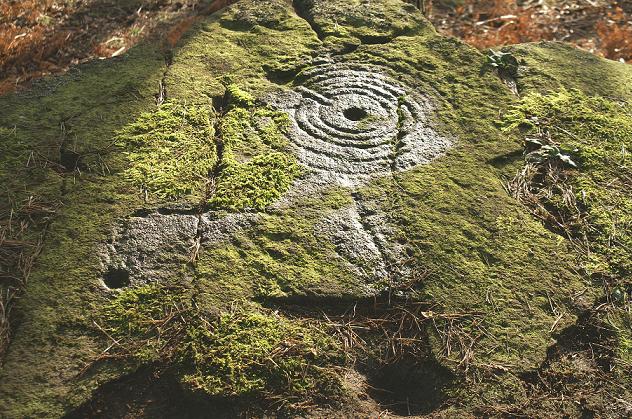
West Agra submitted by rich32 on 9th Jan 2006. West Agra, nr Masham, N Yorks - SE1424681758
(View photo, vote or add a comment)
Log Text: Google maps showed it was only just over 10 miles between Thornborough Henges, which we had just visited, and West Agra. Stopping off in Masham for a cup of tea, we need to take a minor road passing through the small villages of Fearby and Healey. We took a wrong turn which lead us down over the River Burn and to a reservoir, so we had to turn back and take the higher road past High Barn and Gollinglith Foot. Just after the road had done a sharp right/left about 1km past Gollinglith Foot, the entrance track to West Agra Farm appeared on the right hand side; there is room for 2 or 3 cars to park at the bottom. We then walked along the road for about half a kilometre to where the footpath heads off right up the hill (note coming back there is another footpath which is not marked on the map but passes about 100 yards in front of the farmhouse and leads back to the road). The footpath appears steep, but it’s on a soft, well kept grassy path, and is easy to climb. After the second gate, the area becomes a Site of Special Scientific Interest, with many different types of bird nesting in the area around.
We followed the trackway up to the junction of the drystone wall with the plantation, to our right hand side. Just before the end of the wall there is a gate into the field, then another gate to the north which leads into the plantation. We did go into the fields and the plantation, only later finding out we should have asked permission from Swinton Estates to walk across their land and through the plantation.
The West Agra site has at least 9 prehistoric carved rocks in 7 different areas on the southern side of West Agra Plantation and in the fields around West Agra Farm. They are significant because of the number of different carvings in the same area. 6 of the carvings are on individual rocks; the seventh is in a group of closely spaced rocks on the westerly side of the field system around the farm, which show heavily weathered cup marks. During the summer, the rocks within the plantation are covered by heavy bracken and mossy growth; it would be interesting to return in the winter months to find the rest of the stones.
We walked past the group of rocks in the field immediately to the east of the footpath, but couldn’t see any rock art; on our way back down to the car, we looked again, and because the light had changed, cup marks became very apparent and we wondered why we’d missed them in the first place.
Easiest to spot was the rock lying underneath the drystone wall – there is a great hump in the wall where it travels over the stone, which appears to be bedrock. The ground round the stone is very marshy, particularly on the eastern side of the stone on the other side of the wall, which also has a cup mark. The cup and groove marks on this stone were quite remarkable; the grooves appear to surround groups of cup marks . On the southern side of the stone there were other cup and worn groove marks which looked vaguely like a man, but it was difficult to tell. English Heritage say there are over 40 cup marks with grooved lines on this stone.
Since coming home, we’ve found the map showing the seven different areas, and we’ll definitely go back to see this site again nearer to Christmas.
Thornborough N
Date Added: 14th Jul 2014
Site Type: Henge
Country: England (Yorkshire (North))
Visited: Yes on 14th Jul 2014. My rating: Condition 3 Ambience 4 Access 4
Thornborough N henge submitted by MarionBenham on 4th Nov 2003. N henge Thornborough, despite the trees its easy to see the form of the henge, this pic was taken looking South toward the central henge through the opening in the henge bank.SE281801
(View photo, vote or add a comment)
Log Text: After visiting Thorborough Central (and having tried to see where Thornborough South was), we went back to the Northern Henge. Having driven past the first time and failed to find somewhere to park, this time we spotted where other people had parked, complete with a gap in the trees to nip through.
The henge is completely covered in trees, although the outer banks, berm and inner ditch are visible, although not conducive to good photography. There is a footpath which leads all the way round the berm.
We managed to get to the southern entrance of the henge and looked out to central henge. I've submitted a photograph of the view from one henge to another on the 'Thornborough Central' page.
With the sun coming through the trees and no-one else around, this was a very atmospheric spot.
Thornborough Central
Date Added: 14th Jul 2014
Site Type: Henge
Country: England (Yorkshire (North))
Visited: Yes on 11th Jul 2014. My rating: Condition 3 Ambience 4 Access 4
Thornborough Central submitted by DavidRaven on 28th Nov 2003. Thornborough central, by the southern gap in the henge banks. November 2003.
(View photo, vote or add a comment)
Log Text: I was completely taken back by the sheer scale of Thornborough Henges. Wow. My husband had managed to get the afternoon off, so I picked him up at Thirsk, and we followed the A61 then the B6267 through Ainderby Quernhow, under the A1, until we got to Nosterfield - a distance of just over 9 miles. It didn't help that Thornborough Henges are one third on one Ordnance Survey map (302) and two thirds on another, which I didn't have with me. However .... Turning left at Nosterfield, we drove past the Northern Henge, but there was nowhere to park, so we decided to carry onto West Tanfield, where we turned left at the mini roundabout, then the next left, towards Thorborough. Back Lane, as I think this is called, goes right past the quarries and immediately to the southern end of Thornborough Central. We bumped up onto the grass verge about 100 yards away and walked back to the Henge. Up and over the very rickety style (one leg was at 45 degrees to vertical) and over into the field.
The scale of this henge was too big to take in - certainly almost too big for the camera. The outer banks of the henge are largely still in place, although it looks as though people have been digging on top of them, although with the rough grass in the middle of the banks, it wasn't possible to see any of the internal ditches.
After having walked all around the banks, we tried to walk down the side of the farm to the northern edge of the henge, which we thought was a bridlepath coming down from Moor Road, close to the Northern Henge, but the field was full of lively cattle, so we gave up and walked back to Back Lane.
There was a bridlepath heading off left about 50 yards up the road towards West Tanfield, so we decided to walk to the southern henge.
After the first 200 yards, the bridlepath went through a field of very ripe oil seed rape plants, and it was hard going getting through this.
We were almost at the place where we thought the southern henge was located when someone starting shooting very close to the bridlepath; they were shooting at birds, and one came down very near me. Whoever it was didn't respond to our (loud) voices asking if it was safe to continue, so sadly, we had to retreat.
We went back to the car and drove round to Thorborough North, where we found a place to bump up onto the side of the road, where we weren't blocking traffic down this relatively narrow lane.
St Mungo's Church
Date Added: 9th Jul 2014
Site Type: Ancient Cross
Country: England (Northumberland)
Visited: Yes on 9th Jul 2014. My rating: Condition 3 Ambience 3 Access 5
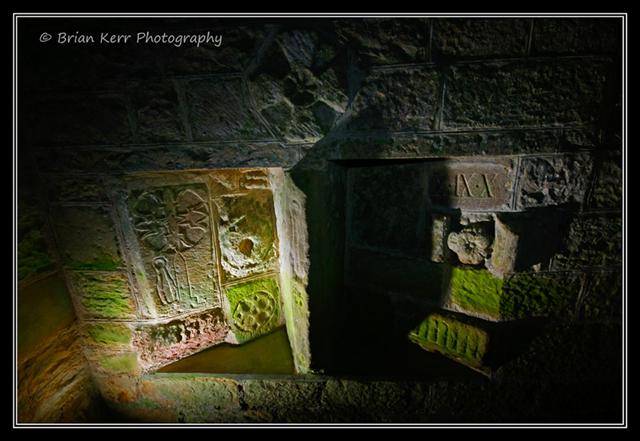
St Mungo's Church submitted by wolfnighthunter on 7th Dec 2008. Christian Cross built into the walls of St Mungo's Church, Simonburn, Northumberland
(View photo, vote or add a comment)
Log Text: I'd read about the hog's-back tombstone located in this church, and as Simonburn is only 20 miles away from our house, took advantage of the sunshine to go and explore. By absolute chance, I happened to arrive at the same time as a small coach party who had booked an organised tour with the vicar, so took myself off to the Old Post Office nearby (the only tea shop in this small hamlet) to have lunch.
Whilst the site of the church is very old, there are only a few small parts of the stone 13th century structure visible; the rest is 18th and 19th century, although if you look hard enough (and use the visitor notes available in the church) it's possible to spot some old gems of tombstones and other features built into the current fabric of the building.
The remains of the hogs-back tomb is built into the east wall of the porch, placed vertically in the centre of a display of other interesting artefacts, including (quoting from the visitor notes here!): parts of a medieval table-tomb with shears on; parts of two 13th and 14th century tomb covers; in the left and right hand corners examples of Anglian or Roman champfered impost moulding; a piece of double roll moulding with rosettes; part of the original sundial; part of a coat of arms from a medieval tomb and what is purported to be the central boss of the stone cross on the opposite west wall (Note that when you turn round to look at this said stone cross shaft, it has been clearly cut in half at some point).
Above this group there is also the remains of a stone cross.
Even though only a small portion of the hog's back tombstone remains, it is impressive, which miniature roof tiles clearly visible on both sides. The visitor notes say that the tombstone was reused in medieval times, having shears and three rosettes carved on the roof-ridge.
On a previous visit to Simonside recently, we went in search of the old castle (not much remains, and it's apparently a folly anyway), plus an old well near the river (which we couldn't find).
There is parking at the tea shop, or off the road to the left hand side of the church as you enter the village.
Shap Avenue
Date Added: 7th Jul 2014
Site Type: Multiple Stone Rows / Avenue
Country: England (Cumbria)
Visited: Yes on 5th Jul 2014. My rating: Condition 2 Ambience 4 Access 3
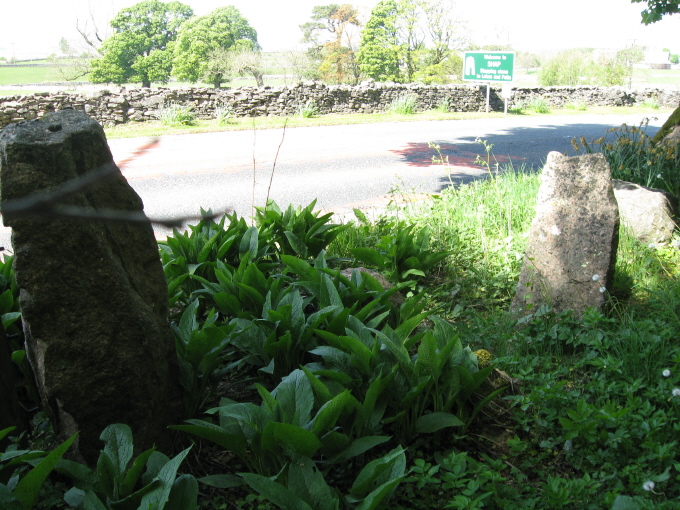
Shap Avenue submitted by AngieLake on 3rd Jun 2011. These were the most noticeable stones fringing the east side of the road, heading back towards the village after visiting Kemp Howe, that might have possibly come from the ancient monuments.
(View photo, vote or add a comment)
Log Text: Armed with information from the Portal and a map of the locations of the stones they've mapped in the stone row so far from Shap Local History Society, we started off at Kemp Howe stone circle, and walked round the village looking for stones. We met a couple of the more senior locals as we went round, and they were keen to help and point out where the stones were, and tell us of others. There are so many stones around and near to the village, most of them clearly on the same alignment that we became quite overwhelmed with the scale and sense of what our ancestors achieved and what it all represented.
We ended up at Skellaw Hill and the Thunder Stone, then had to call it a day, as we wanted to travel over to Swinside Stone Circle before heading off home.
The Shap Stone Row is certainly intriguing, and I came back with around 100 photos of possible stones and locations - I've picked two to submit that aren't already recorded on this page.
Well worth exploring, and whilst visiting, I'd also recommend hopping down to Shap Abbey and Keld Chapel nearby, too. Both are free to get into, and are in picturesque locations, with a lot of history attached.
Kemp Howe
Date Added: 7th Jul 2014
Site Type: Stone Circle
Country: England (Cumbria)
Visited: Yes on 5th Jul 2014. My rating: Condition 2 Ambience 2 Access 4
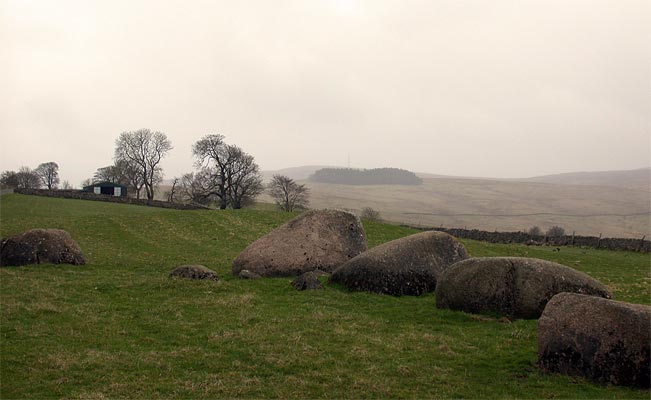
Kemp Howe submitted by nicoladidsbury on 29th Mar 2004. This is the remains of what must have been a beautiful stone circle. The stones are pink granite and have a lovely glow. Unfortunately the ambience has been shattered by the "wonderful" victorians, who built the railway on top of it.
(View photo, vote or add a comment)
Log Text: Having been kept awake most of the night by heavy, heavy rain, then being greeted by leaden skies with a distinctly autumn feel, the weather in Cumbria, according to the weather forecast, seemed a lot more appealing.
Armed with information from the Portal and a map with the locations of stones in the Stone Row from the Shap Local History Society, we hopped in the car and drove west.
We parked at the entrance to the field with Kemp Howe in it (the gate to the field was left wide open, and there was a short trackway up to the stones, although the road was horrendously busy), and walked the 100 feet or so up to the stones. Whilst the grass in the field had recently been cut, the undergrowth round the stones had been left uncut.
I confess to being horrified at the damage done to these stones by the Victorians - what a travesty. We got to admire several trains passing by at very close quarters, and could almost have waved to the quarry men the other side of the railway line. The views of the fells to the west (across the road) and beyond was appreciated and were in stark contrast with what was behind us.
This marked the start of an afternoon well spent exploring the Stone Row in glorious sunshine, with a nice lunch stop at the Shap Coffee Shop in the village, then taking in the stones at the west of Shap Village, finishing with the Tumulus at Skellow Hill and the Thunder Stone.
Swinside
Date Added: 7th Jul 2014
Site Type: Stone Circle
Country: England (Cumbria)
Visited: Yes on 5th Jul 2014. My rating: Condition 4 Ambience 5 Access 3
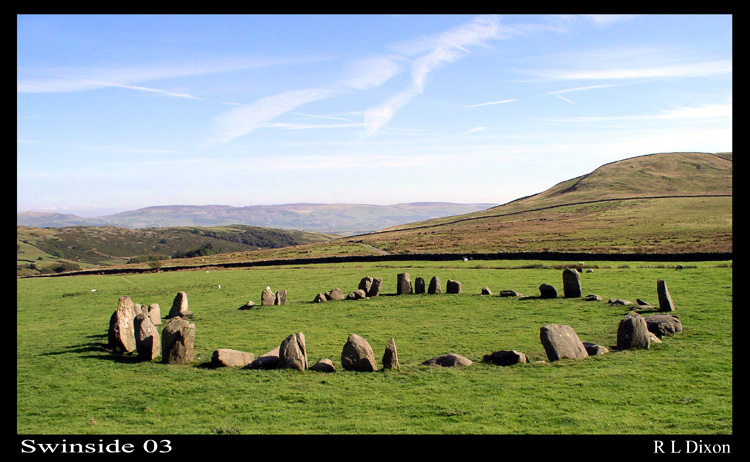
Swinside submitted by rldixon on 15th Jan 2006. Swinside well worth the walk
(View photo, vote or add a comment)
Log Text: After an afternoon spent visiting the Shap Stone Row, my husband was particularly keen to see Swinside Stone Circle, so we took an additional hour to travel to this site. I have to say it was well worth the visit, and I would very definitely go again.
We parked in a small layby just down from Cragg Hall and walked up the marked public bridleway to Swinside (Sunkenkirk) Stone Circle. The first part of the track was steep, but concreted and thankfully short; the rest of the walk was relatively level and had magnificent views. Visibility during our visit was amazing, and we estimated we could see a good 30 miles to the eastern lakes in the far distance. The tide was out, but we had a good view of (what I am assuming from my limited map reading skills!) Duddon Sands in the estuary below until the land levelled out and we could see the circle in the far distance ahead of us.
Surprisingly, we were passed by two separate cars heading up to the farmhouses further up the track - what a remote, but very lovely place to live.
The circle surpassed my expectations. It had a wonderful atmosphere, and I would happily have stayed there until sunset, which, being summer, was a good 5 or 6 hours away, and sadly we had to get home the same evening.
My photographs aren't as good as some of the ones already on the Portal website, so in the images I've submitted, I've tried to pick out some of the features which stood out for me, which include the portal stones at the entrance to the circle.
On reflection, I think we should have climbed up Swinside Fell to get a distant shot of the circle, which would have completed my album for the circle. Next time.
Just to note that in the fields to either side of the bridlepath (particularly the right hand side) leading up to the circle, there were a large number of what appeared to be shaped stones, and we wondered if at one time there had been an avenue leading up to the circle. I've submitted a picture of one stone which has a striking resemblance to the stone in the circle with the quartz banding across it.
Brecken Hills
Date Added: 2nd Jul 2014
Site Type: Hillfort
Country: England (Northumberland)
Visited: Yes on 13th Jun 2014. My rating: Condition 2 Ambience 4 Access 4
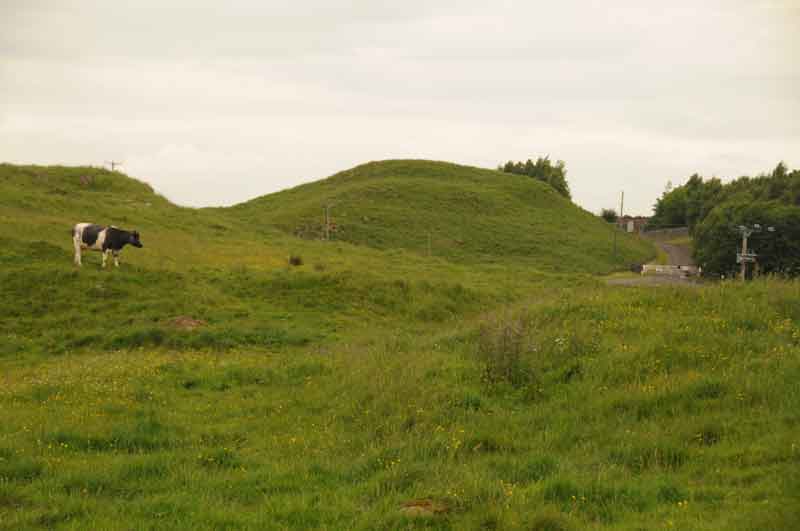
Brecken Hills submitted by Anne T on 17th Jun 2014. Photograph of Blue Crags/Brecken Hills Hillfort taken from gateway at southern edge of site.
(View photo, vote or add a comment)
Log Text: We know this site as 'Blue Crags Hillfort', rather than 'Brecken Hills', so both names are in use. The English Heritage Schedule describes Blue Crags Hillfort as a 'defended settlement of Iron Age/Romano-British date'. It makes excellent use of an existing outcrop of rock (whinstone, from the official records) as part of the defences, and there are very clear ramparts/defensive earthworks on the east, west and south sides of the site, with the main entrance appearing to be to the south west.
We originally went to look at the wells in Colwell (Pricky's well and Coley's Well), but spotted the extensive earthworks of the hillfort marked on the Ordnance Survey map just north west of Colwell, and went to take a look. Blue Crags is situated to the east of the course of Dere Street, with the A68 running between the hillfort and Dere Street.
There is a marked footpath running up to the fort from the west of Colwell, although the visible route vanishes when it reaches the field immediately south of the site, so we followed a vague track through the grass to a large barn which sits at the southern most edge of the hillfort.
The hillfort itself is impressively large and imposing as you walk up to it, as it sits on a hill above you. There is a further footpath that runs north west towards woodland, which would give a superb view of the fort and the outcrop on which it sits, but there were several large bulls, together with cows and their calves in this field, so we trod gingerly trying to get the best photographs from the area around the field entrance to illustrate the site.
On returning home, I logged onto the UK Grid Finder website. The aerial views show about 12 very clear hut circles on the platform of the fort. I will certainly go back in the autumn/early winter to have a closer look.
Houghton Camp, Heddon on the Hill
Date Added: 1st Jul 2014
Site Type: Ancient Village or Settlement
Country: England (Northumberland)
Visited: Yes on 1st Jul 2014. My rating: Condition 1 Ambience 2 Access 3
Houghton Camp, Heddon on the Hill submitted by durhamnature on 16th Aug 2012. Houghton Camp, north ditch and earthworks.
(View photo, vote or add a comment)
Log Text: Return visit on 1st July 2014: I obtained permission from Close House Golf Club to walk across the golf course to look at the settlement from the side furthest from the road. They told me that they are unable to do anything with this parcel of land 'because of the antiquities, but there isn't much to see' and were sure that the farmer they lease the land from would be happy for me to visit, having asked permission.
Parking was a problem again; I tried the field gates next to the road, but they were tied very firmly shut and the next gate to the field with the camp in hadn't been opened in a very long time, so to avoid climbing over, I parked at the Golfing Range and walked back towards the road over the golf course to the settlement - all slightly uphill, but very pleasant in the warm sunshine, and what views back over the Tyne Valley.
I confess to having been disappointed, as the banks and ditches weren't as clear from this side of the site as from the road. Having walked up to the eastern end of the camp, and to the highest point in this landscape adjacent to the field boundary, the yellow (parched) grasses gave a vague indication of where the banks were.
The aerial photographs of the camp show a very clear blunt-ended oval shape, and having driven along this road for many years to and from work, I am determined to have another look in the winter months to see if any structures become clearer.
A local lady told me the nearby farms are historic and are well worth a visit, having medieval features.
First visit on 18th June 2014: I was visiting Heddon-on-the-Wall today, to see the section of Hadrian's Wall at the east edge of the village, plus the ancient church of St Andrew's in the village centre, and spotted this settlement on the Portal.
I had to drive past several times and eventually managed to park in a field entrance. I did try driving down the entrance to Close House Golf Course/Hotel, to see if I could walk across the grounds to see the site from the south, but there was nowhere to stop at all.
The photograph on the Portal was very helpful in identifying the part of the field the settlement was in, as I struggled to separate the ditches/boundaries of the settlement from the works that had been done for the pylon on the east side, and the golf course on the west. Away from the field entrance, the hedges were too high (for me) to see over.
I have applied to the landowner for permission to walk across the fields to get closer to the settlement, to take photographs from a better angle, so will report back if I manage to get agreement, and re-visit this site (which is only a few miles from my house).
The Cockpit
Date Added: 1st Jul 2014
Site Type: Stone Circle
Country: England (Cumbria)
Visited: Yes on 28th Jun 2014. My rating: Condition 3 Ambience 4 Access 3
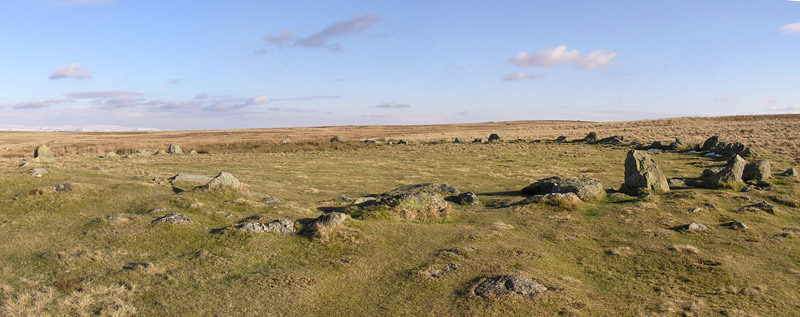
The Cockpit submitted by LivingRocks on 18th Mar 2005. A panoramic view of the Cockpit Stone Circle which according to Magicmap ‘includes a circular kerbed stone bank 2.8m -11.2m wide and up to 0.5m high which encloses an area approximately 27m in diameter. There are 27 (?) standing and recumbent stones set largely into the internal face of this bank, thereby creating the stone circle. The tallest standing stone measures about 0.95m high and some of the recumbent stones are up to 1.9m in length. Within the eastern side of the stone circle, abuttin...
(View photo, vote or add a comment)
Log Text: Almost at the course of High Street Roman Road, there is a view of Ullswater from the footpath just below the Cock Pit Stone Circle.
As the circle is on a good footpath, most of the people stopped at the circle. It's always nice to see people appreciate ancient sites, but I had to wait quite a while to get take photographs without anyone else in it! We found a couple of the outlying stones, and identified a couple of cairns nearby, but couldn't get good enough photographs to make these out properly.
By standing just below the circle, on the main footpath, it's possible to make out the bank.
Well worth a visit, and the view of Ullswater and Pooley Bridge below was worth the easy walk.
White Raise Cairn
Date Added: 1st Jul 2014
Site Type: Cairn
Country: England (Cumbria)
Visited: Yes on 28th Jun 2014. My rating: Condition 3 Ambience 4 Access 3
White Raise Cairn submitted by baz on 3rd May 2003. White Raise Cairn (NY489224). This 20m. long cairn has an exposed central cist.
(View photo, vote or add a comment)
Log Text: From the footpath leading from the Cop Stone to The Cockpit Stone Circle, this cairn lies after the Cairn Circle, on the right hand side of the footpath.
It initially appears unremarkable as a large mound with stones marking the extent of the cairn, but walking up the slope I came across the excavated burial chamber, which was a great surprise.
It's clearly a favourite with sheep, as the stones retain the heat from the sun, and they were unmoving as we wandering around.
There are great views across the valley towards Ullswater, although it's not quite possible to see the lake from the cairn.
Well worth a visit.
Aspers Field
Date Added: 1st Jul 2014
Site Type: Standing Stone (Menhir)
Country: England (Cumbria)
Visited: Yes on 28th Jun 2014. My rating: Condition 4 Ambience 4 Access 3
Aspers Field submitted by baz on 26th Apr 2003. This stone (at NY558152) lies in the next field to the more well known Goggleby Stone (NY559151), from which I took this picture (with zoom). Both of these stones form a part of the Shap Stone Avenue.
(View photo, vote or add a comment)
Log Text: This stone is within sight of the Googleby Stone, although a little more difficult to access. The gate to access the field is in Keld Lane, but it's difficult to park here, and we were wary about walking in private fields. There were some dog walkers from the nearby caravan park walking in the fields, so we took advantage of a tumbled stone wall to get a photograph of the cup and ring mark.
Having come home and found out the extent of the stone row at Shap, we'll be going back to see more.
Goggleby Stone
Date Added: 1st Jul 2014
Site Type: Standing Stone (Menhir)
Country: England (Cumbria)
Visited: Yes on 28th Jun 2014. My rating: Condition 3 Ambience 4 Access 4
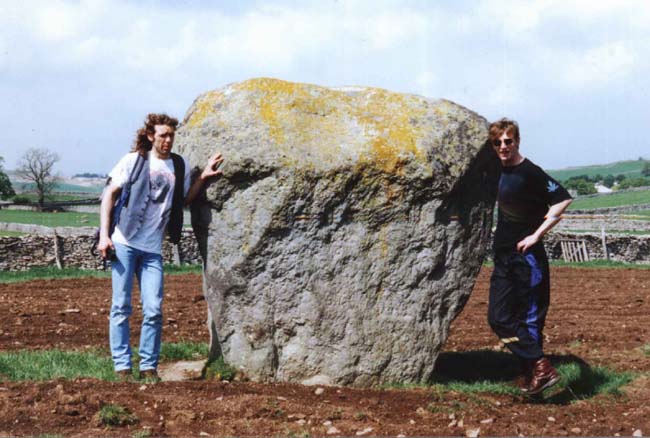
Goggleby Stone submitted by blingo on 30th Jan 2003. Goggleby stone near Shap.
(View photo, vote or add a comment)
Log Text: After failing to park along the narrow lanes around Keld, to see various stones in Shap Row, we finally parked outside the Fire Station on the A6 running through Shap, and followed the footpaths westward to the Googleby Stone and the partially toppled stone in Asper's Field.
This is a short walk, with a couple of stiles to cross, but easy enough.
I was impressed by the size of this stone, although we could discern no cup or ring marks anywhere on it.
I was a bit disappointed to see this stone had been concreted into place to keep it upright!
Cop Stone
Date Added: 1st Jul 2014
Site Type: Standing Stone (Menhir)
Country: England (Cumbria)
Visited: Yes on 28th Jun 2014. My rating: Condition 4 Ambience 4 Access 4
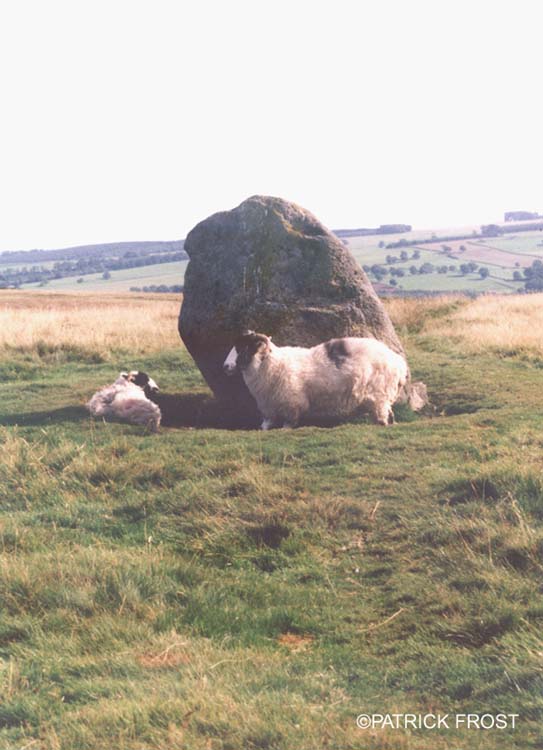
Cop Stone submitted by Patrick Frost on 14th Oct 2002. The Cop Stone in Cumbria at GR: 496216
(View photo, vote or add a comment)
Log Text: For a long time we've wanted to walk along High Street, the Roman Road, but the scramble up from Ullswater side was too difficult for me. My husband managed to identify another route, via the B road through Askham and Helton, then following the track past Outgang Farm and Heltonhead. There were other cars parked on the grass at the side of the road, so we joined them, and walked the 100 yards up to Cop Stone.
This was just the start of our journey through this fascinating landscape; whilst there are obvious quarried area and shake holes, there are a wide variety of cairns and tumuli, with the footpath leading up past The Cockpit Stone Circle and High Street.
The more we looked, the more there was to see. Well worth a visit, and easy walking.
Goatstones Four-Poster
Date Added: 1st Jul 2014
Site Type: Stone Circle
Country: England (Northumberland)
Visited: Yes on 30th Jun 2014. My rating: Condition 4 Ambience 4 Access 4
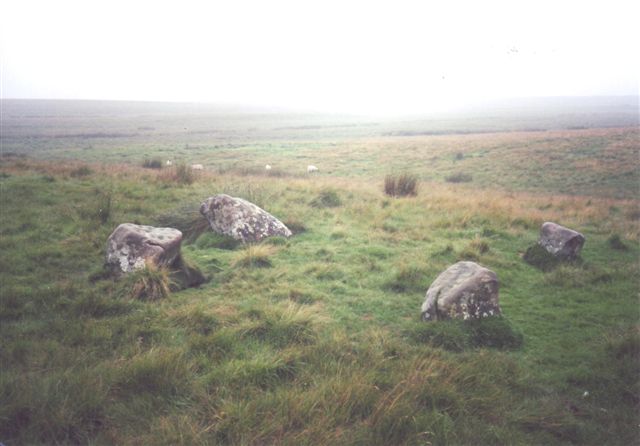
Goatstones Four-Poster submitted by cosmic on 13th Feb 2005. Another of Goatstones courtesy of Ian Simpson
(View photo, vote or add a comment)
Log Text: There are a couple of parking spaces next to 'Manor House' on Ward Lane, just below Ravensheugh Crags, and followed the footpath up to the crags, turning right up to the stone circle.
It is an easy walk, with spectacular views - the visibility was around 30 miles - we could see the Cheviot Hills in the distance.
The stones of this unusual four poster stone circle are low to the ground (with other outlying stones buried in the grass around?) but very atmospheric. It feels very remote, with very little noise apart from birdsong, although there is a steady (but small) stream of traffic along Ward Lane.
There are very definite cup marks on the eastern most stone, and other possible cups on the southern most stone (now partly toppled and hidden by marsh grass).
We met the farmer from Great Lonbrough, at the very end of the footpath, and he told us more about the hut circles and cairns in the fields below. We checked the Portal when we got home and were inspired by the photographs of the rock art at Goatstones, so we intend to go back and look again in the next few weeks and look at these, plus also walk along to Standingstone Rigg.
Will most definitely visit again.
Bygate Hill
Date Added: 23rd Jun 2014
Site Type: Standing Stone (Menhir)
Country: England (Northumberland)
Visited: Yes on 22nd Jun 2014. My rating: Condition 3 Ambience 4 Access 4
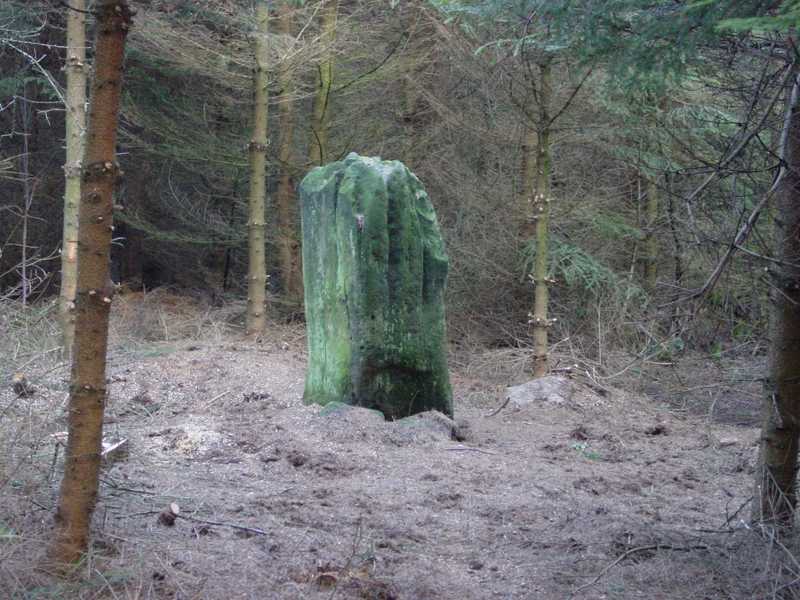
Bygate Hill submitted by PaulH on 3rd Mar 2003. Northumberland
NZ069770
(View photo, vote or add a comment)
Log Text: Having previously visited the site the weekend previously, we were put off from going in by alarms coming from within the plantation and a notice 'not to enter without the necessary authority' on the gate, so I sought the landowner's permission to enter. Bygate Hill Plantation houses a telecommunications mast (which apparently requires a permit to go near) and the landowner told me there are also regular paintballing activities carried out within the plantation.
There is a grassy track from the gate to the mast, with a small track running off to the right (just before the mast) through the trees which leads to the stone which stands in a small clearing.
The standing stone itself is impressive, and very atmospheric amidst the trees with the sunshine breaking through.
The land surface has clearly built up with all the leaf debris built up around the base of the stone, which also appears to have been propped up on one side by two smaller stones, to stop it leaning further.
There also appears to be a smaller buried (heel?) stone within a few yards of the main stone.
Had it not been for the trees, the site would command superb views of the surrounding land. We later walked up to West Bitchfield Peel Tower (grid reference: NZ 09081 77126) and looked back towards the plantation. The views were magnificent.
The landowner told me that Buddhist Monks from nearby Harnham Monastery regularly visit the stone and hang bells, and indeed there are charms and wind chimes on the trees surrounding the stone, and offerings placed on top of the stone.
Roughting Linn Rock Art
Date Added: 20th Jun 2014
Site Type: Rock Art
Country: England (Northumberland)
Visited: Yes on 20th May 2014
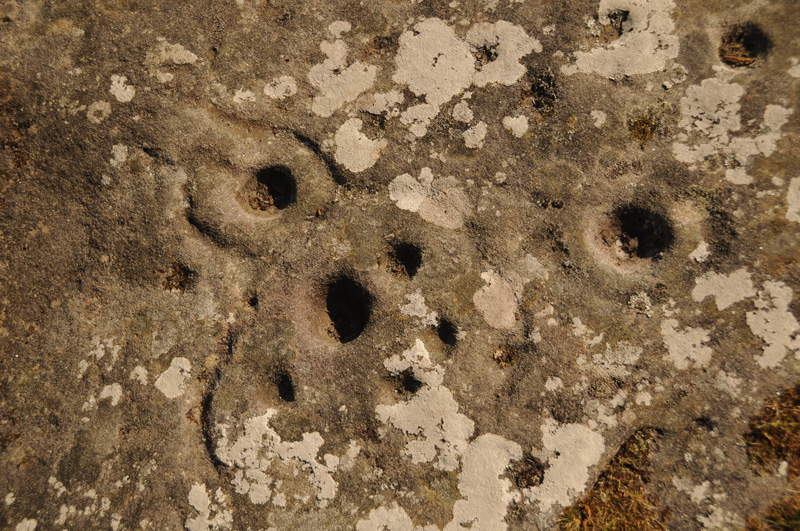
Roughting Linn Rock Art submitted by Anne T on 20th May 2014. Close up of some of the marks on the Roughting Linn outcrop.
(View photo, vote or add a comment)
Log Text: None
Middleton Standing Stone (Northumberland)
Date Added: 20th Jun 2014
Site Type: Standing Stone (Menhir)
Country: England (Northumberland)
Visited: Yes on 27th May 2014
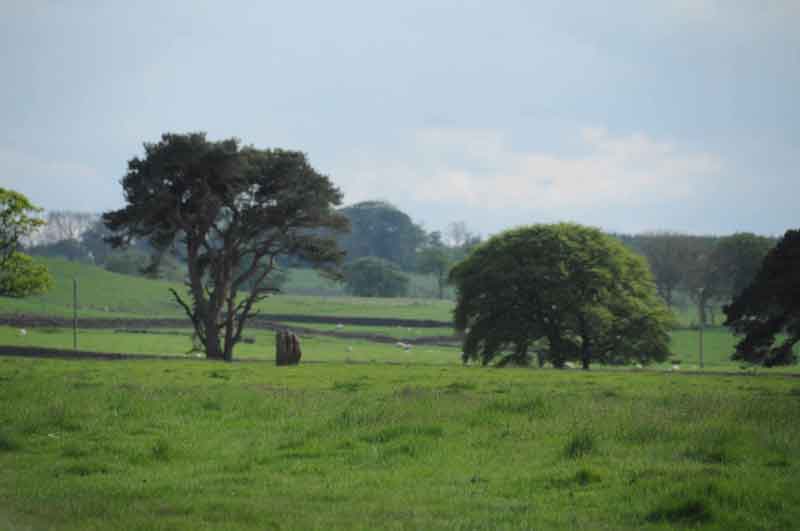
Middleton Standing Stone (Northumberland) submitted by Anne T on 27th May 2014. Middleton Standing Stone in the context of the landscape, looking towards the south west.
(View photo, vote or add a comment)
Log Text: None
Meg's Well, Aydon
Date Added: 20th Jun 2014
Site Type: Holy Well or Sacred Spring
Country: England (Northumberland)
Visited: Yes on 28th May 2014

Meg's Well, Aydon submitted by Anne T on 28th May 2014. This is a view of Meg's Well from the road through the village, just below Aydon Cottage, adjacent to the footpath running towards Aydon Castle. The field appears to be private, and when we visited was full of livestock, so there's no direct access. I wouldn't have recognised the well without having already seen an image on the Megalithic Portal (so thank you!). There are no signposts to the well, and the site is very sadly neglected. I haven't been able to find much about the history of the ...
(View photo, vote or add a comment)
Log Text: None
Bow Bridge Homestead
Date Added: 20th Jun 2014
Site Type: Ancient Village or Settlement
Country: England (Northumberland)
Visited: Yes on 28th May 2014
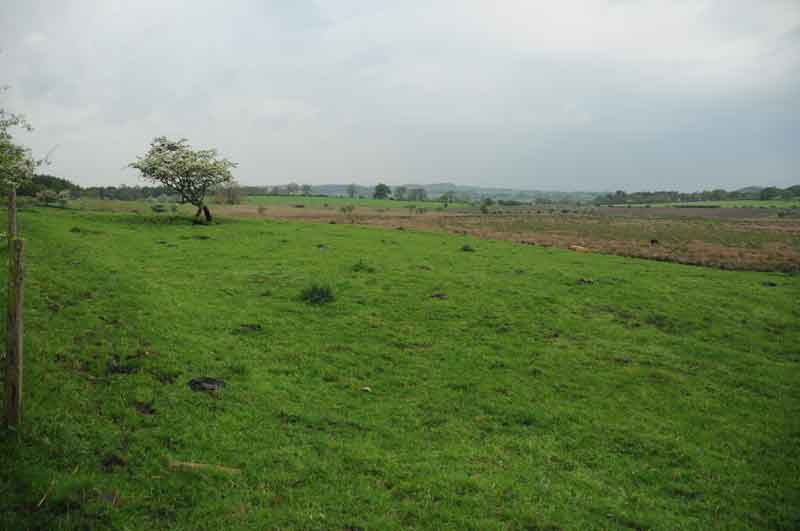
Bow Bridge Homestead submitted by Anne T on 28th May 2014. Image of Bow Bridge Settlement, near Aydon, Northumberland, taken from the road. At the time of our visit, there was a very large bull with his ladies in the field, so I didn't venture nearer! You can see a very clear settlement platform, looking down onto Shildon Bog (right hand side of photograph). The settlement runs underneath the road. We had a quick look for signs on the opposite side of the road, but at first sight appears to have been ploughed out.
(View photo, vote or add a comment)
Log Text: None
